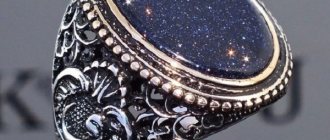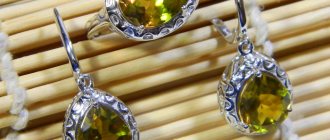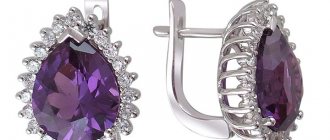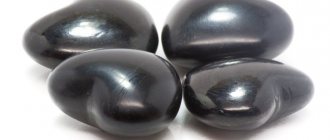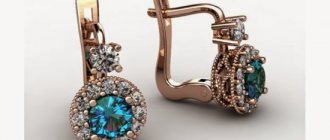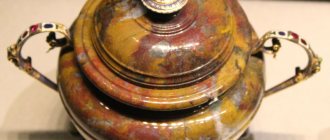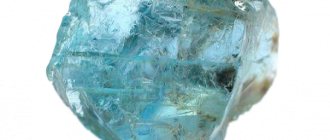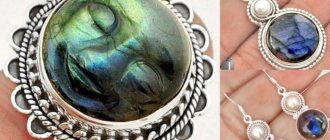Alexandrite is a mysterious, mysterious stone that was discovered quite recently. It is not for nothing that this mineral was named after the king, so it is associated with wealth, power, nobility, and is also a first-order stone.
Story
Even in ancient times, humanity was familiar with this precious stone. In the ancient Indian epic "Mahabharata" it (or ordinary chrysoberyl) was called the "peacock's eye".
There are two approximately equal in probability versions of the discovery of alexandrite.
Nils Nordenskiöld, a Finnish mineralogist, discovered a strange stone in the Ural Mountains in 1834. At first he thought that this was a suspiciously strong emerald of not the first purity, but in the light of the lamp the green gem turned into a crimson “ruby”. Soon the scientist named the amazing find in honor of Alexander II, who at that time was celebrating his coming of age (at that time, from the age of 16 a person was considered an adult).
There is another discoverer - Yakov Kokovin, who sent a sample of emerald found in 1833 to St. Petersburg. The Minister of Appanages, Lev Perovsky, took up the study of the specimen, and later gave the unusual find to the future Emperor Alexander II as a gift for his coming of age. As a result, the stone named after the tsar became his personal talisman, and, perhaps, it was he who protected him in difficult times for Russia.
In the Russian Empire, the stone was highly valued and worn only by noble people (green and red are the traditional colors of the nobility), so it was more expensive than some diamonds. Only after the First World War did alexandrite gain fame as a “widow’s stone”, because it was owned by noblewomen whose husbands did not return from the battlefield. Alexandrite then began to be associated with pain and loss.
Since the announcement of the discovery of the stone in 1842, alexandrite has long been called the “original Russian stone,” but towards the end of the 20th century, after the discovery of new foreign deposits, the mineral ceased to have a patriotic connotation.
Production
The first and one of the largest deposits of alexandrite is the Malyshevskoye deposit, located in the Ural Mountains. In addition, this mineral is mined in Sri Lanka, Madagascar, India and Tanzania. Brazil also used to have a deposit, but it was soon depleted.
Alexandrite is a rare gem. Even in the large Malyshevsky deposit, among the tons of processed rock there is only one hundred grams of the mineral. For this reason, the “imperial stone” is very expensive, and not everyone can afford it.
Alexandrite deposits
Until the end of the twentieth century, alexandrites were mined only in the Urals, where the only primary deposit in the world is located, which, unfortunately, has already been depleted and has not been developed since 1995. This stone is extremely rare in nature. Currently, placer deposits of alexandrite have been discovered in Brazil, Sri Lanka, Tanzania, Madagascar, but in terms of the brightness of color and the contrast of its changes, Ural stones are still considered the best in the world and the most expensive.
Advertising - Continued below
Features of the mineral
Alexandrite (chemical formula – Al2BeO4) is a type of chrysoberyl with an admixture of chromium.
Chrysoberyl, despite its name, is not a type of beryl, which includes aquamarine, emerald, morganite and others. The famous feature of the “widow’s stone” is pleochroism (from the ancient Greek “many colors”). An unusual stone, like a chameleon, changes its color: green under sunlight, purple or red under electric light. Other minerals (aquamarine, tourmaline, zircon) also have pleochroism, but it is in alexandrite that this quality is most clearly expressed. This feature is explained by the presence of chromium, the atoms of which are “sewn” into the structure of the mineral.
The amazing properties of the alexandrite stone do not end with the color reverse:
- Hardness 8.5 on the Mohs scale;
- Glass shine;
- The stone can be transparent or translucent;
- The fracture is conchoidal;
- Cleavage is imperfect;
- Density 3.5-3.84 g/cm3.
Properties and uses of stone
The main niche for using alexandrite is jewelry. Large specimens go into private collections. Due to its rarity and cost, the stone is rarely used for medicinal and magical purposes.
Physical properties
The chemical formula of alexandrite Al2BeO4 indicates that the composition includes aluminum and beryllium oxide. Properties of the stone:
- changes color under infrared or fluorescent lighting;
- hardness on the Mohs scale – 8.5 units out of 10;
- density – 3.6–3.8 g/cm³;
- resistant to acids (with the exception of hydrofluoric and boric);
- unstable to alkalis;
- melting point – 1800 °C;
- does not magnetize.
View this post on Instagram
Publication from Silver and natural stones (@_silver_stories_) January 15, 2021 at 7:36 PST
Medicinal properties
It is believed that the gem helps with:
- varicose veins;
- diabetes mellitus;
- osteochondrosis;
- weak blood vessels;
- alcoholism;
- liver and gallbladder diseases;
- insomnia;
- depression;
- neurosis.
The magical properties of alexandrite
The stone is actively used by magicians, astrologers, and worn as amulets and talismans. He is credited with the ability to:
- give inner harmony;
- help in the fight against life's difficulties;
- develop creative abilities;
- improve mood;
- bring good luck in financial matters and transactions;
- warn of impending changes and troubles by changing the color of the glow to yellow;
- improve performance.
Alexandrite can enhance both positive and negative emotions of the owner. Therefore, it is not recommended for long-term wear.
It is believed that alexandrite can lead to separation from a loved one, so it should be worn in pairs, for example, a ring and earrings or a bracelet and a pendant. It is combined with sapphire, garnet, topaz, and citrine.
A little about the unusual properties of the stone in the following video:
Which zodiac sign is alexandrite suitable for?
Not all zodiac signs can wear the stone - choleric natures will receive a negative impact in the form of increased temperament and manifestations of incontinence. Not recommended for wearing by Virgos, Cancers, Aries. Positive effects of the mineral:
- It will help Geminis find harmony, peace of mind, solutions in life situations;
- It will give Scorpio the strength to fight with himself, to increase the level of development, especially spiritual;
- Leos will be given success and career advancement;
- will reveal the talents of Aquarius, develop intuition;
- Libra will be given a variety of thinking and a creative approach to business;
- It will help Pisces develop logic and increase reaction speed, especially in case of danger;
- will calm the emotions of Taurus, soften outbursts of anger and irritability;
- It will help Sagittarius achieve their goals, become more self-confident, and realize their ideas.
Also watch the video interview about the stone:
Stone color variations
Alexandrite is unique in its ability to change color. Under the rays of the sun, the mineral takes on green, olive or bluish shades, and under artificial lighting it turns into a pink, purple or red stone. Under some other lamps, alexandrite even turns yellow.
There are three varieties of alexandrite:
- Ural stones are the highest quality stones with the most clearly defined pleochroism;
- African and Brazilian - duller with a less pronounced color reverse effect;
- From the island of Sri Lanka - unique alexandrites with opalescence and a “cat’s eye” effect.
Varieties of mineral
Without knowing what this “chameleon” is, it is very easy to stumble upon a fake. Before buying products with alexandrite, understand what distinctive properties it has:
- the color of alexandrite in daylight ranges from blue to green shades;
- when in a room where lamps are turned on or candles are lit, the gem changes its color to a blood-crimson color.
This is general information to help distinguish an artificial alexandrite stone from a real one. But it is a mineral found in several varieties. Each of them has its own differences depending on the deposit.
Alexandrite changes its color depending on the lighting.
For example:
- The Ural species is recognized as the mineral with the most beautiful color palette. In artificial light it appears purple or violet.
- Brazilian. It has smoother transitions between colors compared to the bright contrasts of the Ural mineral.
- The Indian gem plays green-blue hues in daytime color.
- The color of stone mined in Sri Lanka appears duller in sunlight and has a brownish tint.
Properties
Magical
Alexandrite is a stone of people who love to change their lives and put it at risk. It attracts good luck, prosperity in love affairs, and inspiration. The stone lifts the mood, enhances the owner’s emotions, and increases creativity. The "Widow's Stone" is associated with the other world and has the ability to predict the future. If your jewelry suddenly turns red in daylight, this indicates that the owner will experience something related to blood loss, injury or injury. If alexandrite takes on a golden hue, then it warns of a dangerous life situation.
Alexandrite brings its owner a stormy life and risk, so only a strong person who knows how to control himself will receive a reward after all the trials. This stone is not suitable for peaceful, quiet, calm people who do not like change.
Healing
The main “specialization” of alexandrite is the circulatory system. The main colors of alexandrite - green and red - symbolize two types of blood - venous and arterial. This stone strengthens the walls of blood vessels, maintains normal heartbeat and blood pressure, treats diseases of the blood vessels, and prevents the formation of blood clots.
Alexandrite also improves the functioning of the gastrointestinal tract and calms the nervous system. Water infused with alexandrite also helps treat alcoholism, dulling the craving for alcohol.
Alexandrite is best worn during the day, and at night the gem should rest.
Interesting Facts
- Interestingly, not a single natural alexandrite was officially sold in the Soviet Union. This stone was recognized as a state treasure and prohibited for free sale. All items that contained "Alexandrite" were actually decorated with synthetic corundum.
- Among the people, alexandrite has long been considered a “widow’s” stone. This is due to the fact that the gem gained popularity in the post-war period. And many women who lost their husbands wore jewelry with artificial alexandrites. Thus, a prejudice arose that this mineral was a source of grief for the family.
Stone and zodiac circle
Alexandrite is a stone of the water element, with its iridescence personifying the impermanence of the forms of water. It is ruled by Saturn and is recommended for anyone who is willing to take risks and achieve more out of life. The stone brings good luck, inspiration, creative powers to most zodiac signs; even the quiet Pisces will be favored by the stone.
It is not recommended to wear it only for Cancers, Virgos and Taurus, because not every representative of such a sign will withstand the changes caused by the stone. Sagittarius and Aries need to wear alexandrite with caution, as it can make the energy of these signs wild and untamed.
When purchasing alexandrite, it is important to focus on your own feelings. If it suits your horoscope, but something inside is against it, then it’s better not to buy it.
Meaning of zodiac signs
According to astrologers, this precious mineral is suitable for the zodiac signs of the Water element, as well as for the Earth element. The energy that the gem is capable of transmitting is influenced by two constantly opposing planets, namely Mars and Saturn.
Jewelry and amulets with alexandrite are recommended to be worn by those people whose horoscope is: Gemini, Aquarius, Pisces and Scorpio. A precious crystal will bring good luck to people born under the zodiac constellation Aries and Taurus. It is these signs that alexandrite will bring success, fame, prosperity, good luck in any endeavors, and will help them cope with all life’s difficulties and adversities.
It is not recommended to wear jewelry with alexandrites for Sagittarius, Cancer, and Virgo. The gem can weaken energy and attract bad luck.
How to distinguish from a fake
It is logical to assume that the magical and healing abilities of the stone will only work if the stone is real and not counterfeit. Due to the fact that alexandrite is rarely found in nature, imitations made from garnet, corundum or simple glass can often be sold on the market for huge sums of money. There is nothing wrong with these minerals (except glass), but if alexandrite is what you need, then it is better to avoid unnecessary disappointment and expense.
In fact, it is quite difficult to determine which stone is real, so it is better to check it in the laboratory and ask a specialist for help. You shouldn’t order a stone online yet, because it’s difficult to identify an alexandrite stone from just one photo.
The main signs of a counterfeit stone:
- The size is too large, because specimens with a diameter of 6 millimeters are extremely rare;
- The seller does not have a certificate of authenticity of the gem;
- There are very few antique jewelry, so if you are offered “antique” jewelry with alexandrite, you should be wary;
- The glass fake does not have the effect of pleochroism, it just sparkles with an iridescent sheen, and also does not have the strength characteristic of alexandrite;
- A synthetic crystal will have crystal transparency and spherical bubbles inside (in alexandrite they have the shape of drops);
- If alexandrite turns yellow rather than red under artificial light, then it is artificial corundum;
- Andalusite also has pleochroism, but under a certain view a rainbow shine appears, which is absent in a real stone;
- Imitation spinel under artificial light will turn purple rather than red.
Is Alexandrite a widow's stone?
One of the popular beliefs says that alexandrite is the stone of widows and loneliness, and under no circumstances should you wear one stone, so as not to become a widow.
This sign is quite easy to explain if you look into history. The fact is that the fashion for this stone came in pre- and post-war times, when many wives lost their men at the front. Therefore, it was believed that the stone brings death and loneliness. But do not forget that all Soviet-era jewelry had inserts of a synthetic mineral, and this sign in no way applies to a natural gem.
But if you still believe in omens and are afraid of loneliness, wear not one stone, but two or three. In this case, the mineral will certainly not have a negative effect.
Application
Alexandrite, unlike the universal diamond, is used only in jewelry. The price of alexandrite stone is high, since the mineral is very rare. There are few large specimens, so you can hardly see stones larger than one carat in jewelry. Imperial gems are most often set in gold or platinum; silver is not used for this stone.
The most common cut is brilliant (57 facets); Ceylon alexandrites with a “cat’s eye” effect are cut in cabochons.
How to distinguish artificial stone?
As we have already noted, true alexandrites are very rare. After all, silicon, the second most abundant substance on earth after oxygen, should not enter into the process of their formation. If you still think that you are very lucky and you have “attacked” the trail of a real stone, before taking it to the laboratory, try to determine for yourself whether it is real. A gross fake can be identified as follows:
True alexandrites are very rare. After all, silicon, the second most abundant substance on earth after oxygen, should not enter into the process of their formation.
If you still think that you are very lucky and have “struck” the trail of a real stone, before taking it to the laboratory, try to determine for yourself whether it is real
Carefully examine the stone in the light; after all, purely violet alexandrites do not exist in nature - they must have a reddish or pink tint
- carefully examine the stone in the light; after all, purely violet alexandrites do not exist in nature - they must have a reddish or pink tint;
- unlike a natural one, an artificial sample will look perfectly transparent and not have any inclusions;
- You should also pay attention to its weight: the average weight of alexandrite does not exceed a carat; stones that are too large are very rare, so they will be prohibitively expensive.
If the stone is not a crude imitation, but a product grown in a laboratory, only a professional can determine this with the help of special equipment.
Unlike a natural one, an artificial sample will look perfectly transparent and have no inclusions
You should also pay attention to its weight: the average weight of alexandrite does not exceed a carat; stones that are too large are very rare, so they will be prohibitively expensive
If the stone is not a crude imitation, but a product grown in the laboratory, only a professional can determine this with the help of special equipment
Advice! In Russia, it is almost impossible to buy jewelry with a real alexandrite stone (photo), even if you are a wealthy person. Our jewelry workshops do not deal with such items. You need to go to the USA for them. Moreover, the cost of even “simple” stones with slight cloudiness will average from 2 to 6 thousand dollars/carat.
Care and wearing rules
There is a belief that the “widow’s stone” is a purely male gem, and it will only bring misfortune to women. However, a representative of the fair sex can prevent the bad influence of the stone by purchasing it in pairs (earrings, ring + pendant set, etc.) or with a diamond as a neighbor.
The stone is durable enough to be worn all day, but it should not be exposed to chemicals when, for example, doing household chores. It should also be stored in a separate suede or flannel bag, and not placed with other jewelry, since alexandrite, having accumulated negative energy during the day, can “share” it with other gems.
Alexandrite should be washed with warm water and soap, dirt and dust should be removed with a soft brush, and wiped with a soft cloth after washing.
Magical influence
Jewelry with natural gems is beneficial for the body:
- cleanses and strengthens blood vessels;
- improve the functioning of the gastrointestinal tract and nervous system;
- treat infectious diseases;
- The water in which the jewel has lain relieves alcoholism.
Alexandrite jewelry prolongs youth and life. But it is recommended to wear them during the day and take them off at night.
Earrings with alexandrite
For those who are put off by alexandrite's reputation as a "widow's stone", it is better to wear two pieces of jewelry or earrings.
Alexandrite jewelry is used as a talisman:
- people who are unable to control emotions and thoughts;
- those wishing to achieve unity with spiritual or otherworldly forces, to receive cosmic energy;
- gambling people who consider the gem a “magnet” of sudden wealth;
- confident in their creative potential: the stone will develop these abilities;
- In Europe, a ring with alexandrite is presented to inveterate jealous people or jealous people in order to cool their ardor.
The mineral “communicates” with its owner, changing color. If during the day a green-blue pebble turns brown and red for no reason, and turns green in the evening, problems are not far off. In serious cases, the gem changes color and turns yellow. If the color is emerald, good luck and happiness lie ahead.
According to the Zodiac, it is suitable for Gemini, Leo, Scorpio, Aquarius.
If you feel discomfort while wearing jewelry, it is better to sell it.
All this applies to natural stone.
An artificial gem has no magical or healing properties. However, there is no “widow’s”; it suits all signs of the Zodiac.
| Zodiac sign | Compatibility (“+++” – fits perfectly, “+” – can be worn, “-” – strictly contraindicated) |
| Aries | + |
| Taurus | — |
| Twins | +++ |
| Cancer | — |
| a lion | +++ |
| Virgo | — |
| Scales | + |
| Scorpion | + |
| Sagittarius | + |
| Capricorn | + |
| Aquarius | + |
| Fish | + |
Neighborhood with other stones
Alexandrite is an “imperial” stone, so it only likes proximity to expensive stones. This is that rare stone of the water element that gets along well with the most fiery gems - ruby and diamond, but does not recognize other fire minerals. It pairs well with other aquatic gemstones (especially emerald or pearl). Alexandrite can also coexist with earth gems, but only with the most expensive of them (turquoise, the best specimens of chalcedony, onyx and jasper, jadeite). The "Widow's Stone" is not worn with all air stones.
Artificial alexandrite
Throughout the 20th century, attempts were made to develop a synthetic analogue of alexandrite, since the natural gem is too rare and expensive. Success was achieved by chemists from the Novosibirsk Academgorodok, who learned to grow crystals of an artificial mineral up to 12 centimeters in length. Experiments were carried out using the Czochralski method at a temperature of 2500 degrees Kelvin, as a result of which the crystal was stretched.
Back in Soviet times, natural alexandrite was replaced on the market by artificial corundums grown in such a way that they eventually acquired the ability to change color like a real “widow’s stone.” This imitation was much cheaper than natural alexandrite.
Synthetic mineral
To create an imitation of alexandrite, synthetic corundum and spinel are most often used. Their color varies from blue-gray to pinkish-red. This mineral is available to the average buyer and is almost indistinguishable from the real thing.
The most common synthetic alexandrites were in the USSR, where they were often used as inserts in jewelry. Many people still believe that jewelry purchased during Soviet times contains natural stone. But this is far from true, because alexandrite was considered a state property and was never sold in jewelry stores. Therefore, all Soviet-era alexandrites are good fakes.

